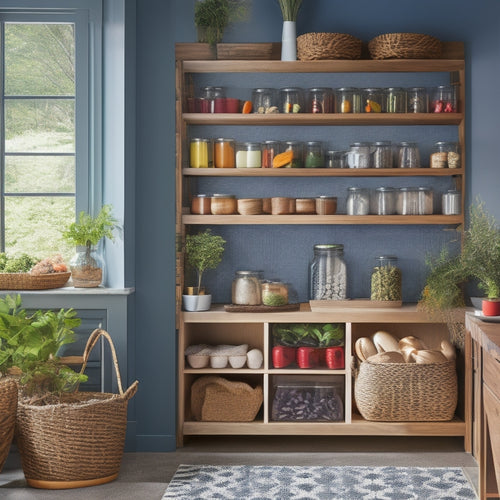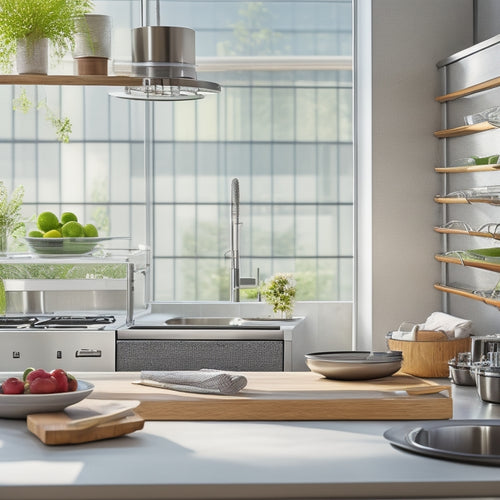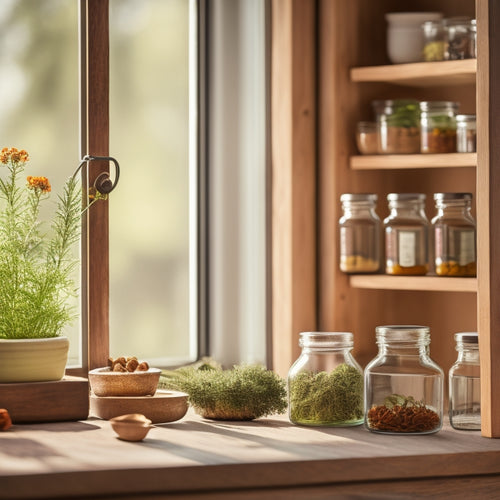
Food Safety: Mastering Preservation and Preparation
Share
Food safety is an essential component of food preparation and preservation, as it directly impacts consumer health and wellbeing. Mastering food preservation basics, such as understanding acidity and moisture control, sterilization techniques, and canning methods, is necessary. Safe food handling practices, including preventing cross-contamination, proper hand and utensil washing, and safe storage, are also vital. A safe kitchen environment, maintained through proper appliance maintenance, regular cleaning, and adherence to cooking techniques, further reduces the risk of foodborne illnesses. By grasping these fundamental concepts, individuals can guarantee a safe and healthy food supply, and explore further to refine their skills.
Key Takeaways
• Mastering food preservation basics, including acidity and moisture control, sterilization, and canning methods, ensures safe and healthy food storage.
• Safe food handling practices, such as separating raw and ready-to-eat foods, prevent cross-contamination and foodborne illnesses.
• Proper kitchen safety best practices, including appliance maintenance and regular cleaning, reduce the risk of mechanical failures and contamination.
• Understanding food handling risks and taking necessary precautions, such as cooking and storing food at safe temperatures, is vital for food safety.
• Implementing proper food preservation, handling, and preparation techniques helps prevent foodborne illnesses and ensures a safe and healthy food environment.
Mastering Food Preservation Basics
Understanding the fundamental principles of food preservation is essential for ensuring the safety and quality of homemade preserves. It begins with grasping the basic concepts of food preservation, including the importance of acidity, moisture control, and proper sterilization techniques.
Mastering food preservation basics requires a solid understanding of canning techniques, storage tips, and the equipment needed to preserve produce safely. A thorough equipment guide is essential for selecting the right tools for the job, from pressure canners to utensils and storage containers.
Safe Food Handling Essentials
Proper food handling practices are essential in preventing foodborne illnesses, and a solid grasp of safe food handling essentials is important in ensuring the safety and quality of homemade preserves.
To achieve this, it is vital to understand the risks associated with food handling and take necessary precautions.
Here are three key essentials to focus on:
-
Separate raw and ready-to-eat foods to prevent cross contamination risks, which can lead to foodborne illness prevention.
-
Wash hands and utensils frequently to prevent the spread of harmful bacteria.
-
Cook and store food at safe temperatures to prevent bacterial growth and foodborne illness.
Kitchen Safety Best Practices
In addition to adhering to safe food handling practices, maintaining a safe kitchen environment is equally important in preventing foodborne illnesses and guaranteeing the quality of homemade preserves.
A safe kitchen begins with proper appliance maintenance, making sure all equipment is in good working order to prevent mechanical failures that can lead to contamination. It is also crucial to master various cooking techniques, such as proper defrosting and reheating methods, to prevent bacterial growth.
Moreover, regular cleaning and sanitizing of kitchen surfaces, utensils, and appliances are essential in preventing cross-contamination. By implementing these kitchen safety best practices, individuals can greatly reduce the risk of foodborne illnesses and ensure a safe and healthy food preservation experience.
Frequently Asked Questions
Can I Use a Slow Cooker to Can Food Safely?
'Using a slow cooker for canning is not recommended, as it cannot maintain the necessary high temperatures and pressures to guarantee safe canning. Instead, opt for traditional canning methods, prioritizing canning safety precautions to avoid botulism and other risks.'
How Long Does It Take for Food to Spoil in the Freezer?
Freezer shelf life varies depending on storage conditions and food type. Properly stored frozen foods remain safe indefinitely, but quality decreases over time. Use safe thawing techniques, like refrigeration or cold water, to prevent bacterial growth and maintain nutritional value.
Is It Safe to Eat Food From a Can That's Bulging?
'A bulging can is a red flag, hinting at potential spoilage and food poisoning risks. It's important to err on the side of caution and discard it, as canning safety guidelines emphasize the significance of avoiding compromised seals and containers.'
Can I Preserve Food Using a Microwave Oven?
Microwave preservation is not a recommended method for long-term food preservation due to uneven heating and potential for undercooking, which can lead to foodborne illness; microwaving leftovers requires careful attention to reheating to a safe internal temperature to guarantee safety.
How Do I Determine if a Canning Lid Is Properly Sealed?
To confirm a properly sealed canning lid, inspect the lid for any signs of imperfection, then verify the seal by pressing on the top of the lid; if it does not move and the lid is concave, it is safely sealed, adhering to canning safety guidelines.
Related Posts
-

Sliding Pantry Storage Ideas for Renters
If you're looking to optimize your rental kitchen, sliding pantry storage solutions could be your answer. Employ vert...
-

Top-Rated Dish Drainers for Kitchen Use
Top-rated dish drainers enhance your kitchen's efficiency and aesthetics. You'll find compact designs that save preci...
-

Spice Rack With Integrated Herb Garden
A spice rack with an integrated herb garden alters your kitchen into a culinary haven. You'll have fresh herbs at you...


